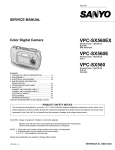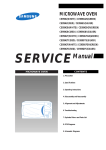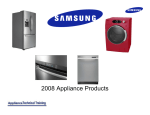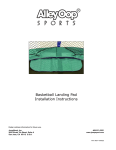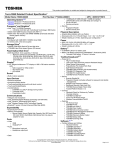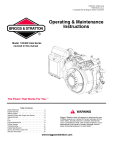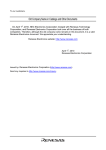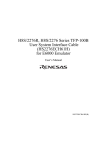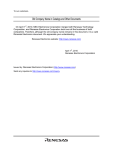Download Samsung SDC-33 Product specifications
Transcript
DIGITAL STILL CAMERA SDC-30 SDC-33 SERVICE DIGITAL STILL CAMERA Manual CONTENTS 1. Precautions 2. Reference Information 3. Product Specifications 4. Disassembly and Reassembly MODE TIMER DELETE 5. Alignment and Adjustment POWER 6. Troubleshooting 7. Exploded View and Parts List 8. Electrical Parts List 9. Block Diagram 10. PCB Diagrams 11. Schematic Diagrams © Samsung Electronics Co., Ltd. JUN. 1997 AD68-20286A / AD68-20289A 1. Precautions 1. Be sure that all of the built-in protective devices are replaced. Restore any missing protective shields. 2. When reinstalling the chassis and its assemblies, be sure to restore all pretective devices, including : control knobs and compartment covers. 3. Make sure that there are no cabinet openings through which people--particularly children --might insert fingers and contact dangerous voltages. Such openings include the spacing between the picture tube and the cabinet mask, excessively wide cabinet ventilation slots, and improperly fitted back covers. (Reading should not be above 0.5mA) Device Under Test Leakage Currant Tester Test all exposed metal surfaces 2-Wire Cord Also test with plug reversed (using AC adapter plug as required) Earth Ground Fig. 1 AC Leakage Test If the measured resistance is less than 1.0 megohm or greater than 5.2 megohms, an abnormality exists that must be corrected before the unit is returned to the customer. 4. Leakage Current Hot Check (See Fig. 1) : Warning : Do not use an isolation transformer during this test. Use a leakage current tester or a metering system that complies with American National Standards Institute (ANSI C101.1, Leakage Current for Appliances), and Underwriters Laboratories (UL Publication UL1410, 59.7). 5. With the unit completely reassembled, plug the AC line cord directly the power outlet. With the unit’s AC switch first in the ON position and then OFF, measure the current between a known erath ground (metal water pipe, conduit, etc.) and all exposed metal parts, including : antennas, handle brackets, metal cabinets, screwheads and control shafts. The current measured should not exceed 0.5 milliamp. Reverse the power-plug prongs in the AC outlet and repeat the test. 6. X-ray Limits : The picture tube is designed to prohibit X-ray emissions. To ensure continued X-ray protection, replace the picture tube only with one that is the same type as the original. Samsung Electronics 7. Antenna Cold Check : With the unit’s AC plug disconnected from the AC source, connect an electrical jumper across the two AC prongs. Connect one lead of the ohmmeter to an AC prong. Connect the other lead to the coaxial connector. 8. High Voltage Limit : High voltage must be measured each time servicing is done on the B+, horizontal deflection or high voltage circuits. Heed the high voltage limits. These include the X-ray protection Specifications Label, and the Product Safety and X-ray Warning Note on the service data schematic. 9. Some semiconductor (“solid state”) devices are easily damaged by static electricity. Such components are called Electrostatically Sensitive Devices (ESDs); examples include integrated circuits and some field-effect transistors. The following techniques will reduce the occurrence of component damage caused by static electricity. 10. Immediately before handling sny semiconductor components or assemblies, drain the electrostatic charge from your body by touching a known earth ground. Alternatively, wear a discharging Wrist-strap device. (Be sure to remove it prior to applying power--this is an electric shock precaution.) 1-1 Precautions 11. High voltage is maintained within specified limits by close-tolerance, safety-related components and adjustments. If the high voltage exceeds the specified limits, check each of the special components. 12. Design Alteration Warning : Never alter or add to the mechanical or electrical design of this unit. Example : Do not add auxiliary audio or video connectors. Such alterations might create a safety hazard. Also, any design changes or additions will void the manufacturer’s warranty. 13. Hot Chassis Warning : Some TV receiver chassis are electrically connected directly to one conductor of the AC power cord. If an isolation transformer is not used, these units may be safely serviced only if the AC power plug is inserted so that the chassis is connected to the ground side of the AC source. To confirm that the AC power plug is inserted correctly, do the following : Using an AC voltmeter, measure the voltage between the chassis and a known earth ground. If the reading is greater than 1.0V, remove the AC power plug, reverse its polarity and reinsert. Re-measure the voltage between the chassis and ground. 14. Some TV chassis are designed to operate with 85 volts AC between chassis and ground, regardless of the AC plug polarity. These units can be safely serviced only if an isolation transformer inserted between the receiver and the power source. 18. Picture Tube Implosion Warning : The picture tube in this receiver employs “integral implosion” protection. To ensure continued implosion protection, make sure that the replacement picture tube is the same as the original. 19. Do not remove, install or handle the picture tube without first putting on shatterproof goggles equipped with side shields. Never handle the picture tube by its neck. Some “in-line” picture tubes are equipped with a permanently attached deflection yoke; do not try to remove such “permanently attached” yokes from the picture tube. 20. Product Safety Notice : Some electrical and mechanical parts have special safety-related characteristics which might not be obvious from visual inspection. These safety features and the protection they give might be lost if the replacement component differs from the original--even if the replacement is rated for higher voltage, wattage, etc. Components that are critical for safety are indicated in the circuit diagram by shading, ( or ). Use replacement components that have the same ratings, especially for flame resistance and dielectric strength specifications. A replacement part that does not have the same safety characteristics as the original might create shock, fire or other hazards. 15. Never defeat any of the B+ voltage interlocks. Do not apply AC power to the unit (or any of its assemblies) unless all solid-state heat sinks are correctly installed. 16. Always connect a test instrument’s ground lead to the instrument chassis ground before connecting the positive lead; always remove the instrument’s ground lead last. 17. Observe the original lead dress, especially near the following areas : Antenna wiring, sharp edges, and especially the AC and high voltage power supplies. Always inspect for pinched, outof-place, or frayed wiring. Do not change the spacing between components and the printed circuit board. Check the AC power cord for damage. Make sure that leads and components do not touch thermally hot parts. 1-2 Samsung Electronics 2. Reference Information 2-1 Circuit description 2-1-1 DSC Digital camera(SDC-30/33), is an image-input device that connects to a PC. It’s small and light welght, supplies high quality images and has a large capacity (4MB/2MB). The digital camera consists of 3 sections: Camera, signal processing and storage. 1. Camera The camera is similar to a camcorder but adapts a scanning method of 525/30 (which can read an entire image of in one frame, whereas the camcorder’s scanning method is 525/60. Photo-exposure is controlled by the electronic shutter through timing generator and CCD driver IC (where as a camcorder controls the exposure using an IRIS). Main function of this part is to control the photo-exposure in accordance with the brightness, and to store the image in DRAM. 2. Digital Signal Processing Image information of 1 frame is temporarily stored in DRAM. Image information stored in DRAM is the digitalized CCD signal from the camera. It needs additional image signal processing by the 32-bit microprocessor. The image signal processing done by the microprocessor includes white balance, shape adjustment and Y/C signal conversion. 3. Storage After image signal processing, an image signal compression technique allows more image to be stored in the limited memory. In the case of SDC-30/33, 10:1 compression is normally executed for standard JPEG specification. After compression, the image information is stored in the nonvolatile flash memory : Max. 45/22 frame for VGA(640*480), and max 180/90 frame for QVGA(320*240). The image can be stored, edited, and printed by the PC image editing program that is supplied with the camera. 2-1-2 Power LCD MICOM generates the control signal that turns on the system (5V). When the power is on, the signal turns on IC140 PWM IC which outputs 5V through T141. When shot key is pressed, the signal for output is generated from MICOM, which turns on IC120 PWM IC and outputs 5V, -7V, and 15V through T121. After the shot, the camera control signal turns off the power supply within. 5sec (through T121). 2-1-3 DC/DC block operation description 2-1-3(A) DC/DC BLOCK CONSISTS OF THREE COMPONENTS AS BELOW. 1. EVER5V EVER5V consists of S8420 (IC100) IC and the assocciat battery circuitry (CN101 Pin2) is input to IC100 (S8420). Pin 8 and 5V voltage are generated internally and are output to pins 1 and 7. EVER5V power (Pin 1) is input to the function board for LCD MICOM (IC601) drive, POWER S/W (LED01) driving power, and PULL-UPvoltage. RESET output of IC100 Pin 5, which changes from low to high at the power input, is connected to LCD MICOM RESET PIN (and resets LCD MICOM). Samsung Electronics 2-1 Reference Information 2. Camera power Camera power block consists of IC120 (PWM IC MB3800), Q121 (INVERTER TR DTC144EU), Q122 (SWITCHING TR KSD1621), and rectifier circuit. When CAM5V control pin of LCD MICOM 10PIN is high, it is converted at Q121 and IC 120. Pin 4 becomes low; then IC120 Pin 7 starts oscillating and the PWM output from IC120 Pin 5 switches Q122. Pin 6 generates the 15V output by a switching pulse and this output is rectified by D121, L123, C127, and C128 to generate 15V power for the drive of CCD (IC201) and V DRIVE IC (MN3112SA). The pulse for -7V (which is generated at T121 pin 10), is rectified by D121, C129, L124, C130 and becomes -7V power for the drive of CCD and V DRIVE IC. The pulse for 5V power, which is output from T121 pin 7, becomes CAMERA 5V power by D122, C133, L127, and C134. The 5V power is divided by D5V for the drive of IC204(MN5246) and IC202(MN3112SA) and A5V for the drive of IC203, IC205, and IC206 through L125. 3. SYS 5V Using the same technique as with camera 5V (L141, IC140, Q142, and T141), the SYS 5V power drives IC301, IC302, IC303, IC304 and IC307, and is generated by SYS 5V CONT from the LCD micom. EVER5V power is always output when battery and adapter are connected; SYS 5V power is output only when power is turned on. CAM power is output for 0.5 second (only during shot operation). 2-1-4 Camera CDS out 1/3" 35 CCD LENS Vout R V1~V4 H1 VSUB H2 V-Drive AGC IN CDS AGC Vout A/D (8bit) D7~D0 Data 8 D15~D0 8-16 CONV. Data 16 DRAM CTRL 16 SMD SHP Timing Gen DRAM 4Mb Address A9~A1 D Data, DCLK HD, VD Camera Ctrl S/W DSCP RISC Chip 1. Camera operation Fig. 2-1 The image from the lens is converted to an electrical signal by the photoelectric conversion component, CCD (MN3776PE). Each pulse used to extract CCD signal is generated by the timing geneartor IC(MN5246), converted to actual driving voltage by V Drive IC(MN3112SA), and supplied to CCD. After noise elimination (CDS) and amplification (AGC) at analog process IC(NN2038FAQ), CCD output signal is converted to a digital signal by A/D converter. The 8-bit digital data is changed to 16-bit by DRAM control IC(SMA9606), and stored in the DRAM. 2-2 Samsung Electronics Reference Information 2. Lens SDC-30/33 lens uses a fixed focus method, and can take a photograph clearly at over 1 meter distance (optimal quality is between 1.5 and 3 meters). 3. Color Filter Color filter, which remove, the color information on CCD, adapts RGB method for best color characteristics and Bayer method for best. 4. CCD(MN3776PE) and V Driver(MN3112SA) R G R G – – G B G B – – R G R G – – G B G B – – CCD converts the optical image to an electrical signal and is similar to an – – – – – – existing camcorder (except for the scanning method). The camcorder method uses interlace scanning, which outputs a field image every 1/60 second. (First – – – – – – field consists of odd lines, the second field consists of even line, and a complete picture consists of two fields. However, SDC-30/33 uses a the progressive scanning method, which outputs a frame every 1/30 second (and has excellent vertical resolution). The image is output at Pin 1 of CCD, and is input to Pin39 of analog signal process IC (IC203) through TR (Q201). V Driver IC (MN3112SA) mixes each CCD driving pulse from Timing Generator IC, and converts it to the required voltage. Effective Pixel 325,546=659(H)X494(V) ØV1~ØV4: Vertical Shift Clock <BLOCK> ØH1~ØH2: Ø Ø Ø Ø Horizontal Shift Clock V V V V V01: Video output 1 3 2 4 15 PW 13 14 12 V e r t i c a l 16 S h i f t VO1 (Bias) L G R e g i s t e r 1 2 VO25 OD 9 SUB 11 PT 4 Horizontal Shift Register 1 Horizontal Shift Register 2 3 Ø R 6 O G 8 7 Ø H 1 Ø H 2 10 SG Fig. 2-2 Samsung Electronics 2-3 Reference Information 5. Timing Generator (MN5246) A timing generator generates each clock, synchronized signal, and CCD driving pulse for the system. Also, it receives the shutter speed information for the photo-exposure control (from the microprocessor). VDO,HDO CLK CSYNC DS1,DS2 SG CH1 Image signal ØSG ØSUB ØV4 ØV3 V3 V4 SUB V2 V1 R H2 bias H1 Signal process CDS ØV2 ØV1 CCD MN5246 VDLIDE 2fck=24.5Mhz Fig. 2-3 6. Analog processing IC (MN2038FAQ) After eliminating the noise (CDS) from the CCD output signal (which is input to Pin39, to DS1/DS2 signal of TG), Analog processing IC outputs it to Pin 46, and then it is input to pin 2 through C232 (for Row Clip and primary amplificationAGC). Then it is output to Pin 35 and Pin 37 of EVR (IC206), which is input to pin 36, which controls AGC. Pin 35 output signal is input to Pin 26 through C218, and is amplified second time at the main amplifier. The offset adjust (pin 16 input) is activated by EVR output signal (Pin 4) and the output (Pin 21) is sent to A/D converter. Fig. 2-4 2-4 Samsung Electronics Reference Information 7. A/D converter (KAD0228) and DRAM Controller (SMA9606) A/D converter converts the analog signal which is output from Analog processing IC to the 8-bit digital signal (24.54Mhz). DRAM Controller is synchronized with Vsync, converts the 8-bit data which is output from A/D converter to 16-bit data, and stores it in DRAM (controlled by the 32-bit microprocessor). MODE AE Data Detect. 2 & Knee, 8bit to 16bit Convert D_OUT(15:0) – TRI STATE OUTPUT (High Z when Power Off) RAS– CASU– CASL– WR– OE– Data Register & SIO AD_IN(9:0) – ADCK IN(12.27MHz) WND1 OUT WND2 OUT DRAM Address Generator VD/HD GEN A–OUT(9:1) EXT VD IN EXT HD IN CLK IN(24.54MHz) H ADJ V ADJ EOC – R/B– BREQ– BACK– SO SCK SI SCS ADDR/DATA BUS CONTROL OE – Fig. 2-5 Samsung Electronics 2-5 Reference Information 2-1-5 Digital Section 1. Overview 8-6 CONV DRAM CTRL Camera Ctrl Flash Memory 16Mb/32Mb DRAM 4Mb S/W DSCP S/W JPEG Memory Ctrl LCD Micom LCD Pannel PC I/F 32bit RISC MICROPROCESSOR Power Control Fig. 2-6 2. DRAM (KM416C256BLT) and flash memory (TC5832FT/TC5816FT) DRAM stores the image signal temporarily and enables the microprocessor to process the signal. Flash memory (nonvolatile) records various system information and the compressed image. 3. 32-bit RISC microprocessor (HD6477043F28) This microprocessor is the core of the system and handles the camera control, image signal processing, image compression, flash memory control, communication with PC, and communication with LCD control MICOM. (Refer to 2-1-6 “System Control” for details.) 2-6 Samsung Electronics Reference Information 2-1-6 Sytem control Dual controller (MICOM) is located in DSC : A RISC chip controls the signal processing, and is the 4-bit MICOM controls the LCD, timer, and switch. Fig. 2-7 1. 4-bit MICOM; Functions and connections 1) PIN connection status - RISC is connected to the 4-bit MICOM (total 7 lines). - Pins 98, 130, and 108 and SCI No. 1 are used. - Pins 132, 133, 134, and 136 are used for communication with 4-bit MICOM. - Synchronized communication is used with 4-bit MICOM. 2) Function - RISC is usally in the standby mode (low-power) because it consumes so much current when it operates. - 4-bit MICOM acknowledges the starting time (for example, when the user pushes the shot key) and sends the NMI pin signal to RISC, so that the standby mode can be changed to the operation mode. The information is sent to RISC through communication port. After RISC executes the appropriate program, it returns to the standby mode. 2. Main function of 4-bit MICOM - Power ON/OFF: 4-bit MICOM turns the PC (main body) on, and turns on the RISC. - Execution of shot: When the shot is executed by the PC key (or main body), 4-bit MICOM signals the shot execution to RISC. When the shot is finished (system 5V and head power 5V), 4-bit MICOM changes the RISC mode to standby mode. - Delay shot: When the delay shot is executed by the PC key (or main body), 4-bit MICOM signals the RISC and supplies the system 5V and head power 5V. Then, the RISC changes to standby mode. Samsung Electronics 2-7 Reference Information - Mode change: When the mode is input by the PC key (or main body), 4-bit MICOM signals the RISC. When the mode is changed, 4-bit MICOM displays it on LCD, and changes the RISC to standby mode. - Delete execution: When the delete instruction is input by the PC key (or main body), 4-bit MICOM signal the RISC and changes the RISC to standby mode. - LCD display: DSC status is displayed. - Error handling: When an error occurs, (or RISC) the error message is displayed on LCD. If the RISC cannot operate, the power is automatically off. - Battery operation: The capacity of battery is classified as "Full", "Half", "Low", or "Battery replacement". For the "Battery replacement" status, only the power on/off function is available, and other functions cannot operate. - Auto power OFF: When any operation has not been executed (three minutes for main body operation, or 10 minutes for PC operation) the power automatically turns off. 3. Main functions of RISC processor - Communication with 4-bit MICOM: RISC operation is completely controlled by the 4-bit MICOM. A synchronization method is adapted for communication between 4-bit MICOM and RISC (with 8-bit*11 byte communication). - DRAM control: RISC processor includes internal BSC. BSC helps RISC to control the DRAM. RISC uses DRAM as though it were internal RAM (with the help of BSC). BSC generates all DRAM control signals by itself. RISC uses DRAM for the image buffer, temp memory for the calculation, and an area that manages the flash memory and FAT(File Allocation Table). - Camera Head control: RISC handles the control of the camera head during the shot. RISC controls the timing generator, ASIC, etc. so that the image data from CCD can be transferred. - Signal processing: RISC executes the signaling processing internally with CCD image data stored in DRAM. After RISC separates CCD data into RGB, and processes detail and gamma, it creates a YUV signal, and executes JPEG compression. The compressed JPEG data will be stored in DRAM again. - Flash memory control: The compressed data (in DRAM) is stored in the flash memory. The file management program is recorded in RISC, and manages the files in the flash memory (file location, file size, etc). - PC communication: RISC processor receives the signal from PC (4-bit MICOM) and activates up RISC. Then, RISC processor sets the flag for the request input from PC, and transfers the flag to RISC. The RISC communicates with PC through the serial port. (PC always requests the PC communication to DSC, but RISC does not request it from the PC.) - Battery level checking: Battery indicator, which is displayed in LCD of 4-bit MICOM, accepts the data from RISC. Battery level checking is executed when the camera head and main board are on. When new battery is inserted, it outputs 6.2V; but the actual voltage drops below 6V after supplying power to the camera head and main board. 2-8 Samsung Electronics Reference Information 2-2 IC Blocks 2-2-1 IC301 (SMA9606) Samsung Electronics 2-9 Reference Information 2-2-2 IC302 (KM416C256BLT) 2-10 Samsung Electronics Reference Information 2-2-3 IC304 (HD6477043) Samsung Electronics 2-11 Reference Information 2-2-4 IC307 (TC5832FT) 2-12 Samsung Electronics Reference Information 2-2-5 IC601 (UPD75P3116GC) 2-2-6 IC501 (MAX232C) Samsung Electronics 2-13 Reference Information 2-2-7 IC203 (NN2038FAQ) 2-14 Samsung Electronics Reference Information 2-2-8 IC204 (NN5248) Samsung Electronics 2-15 Reference Information MEMO 2-16 Samsung Electronics 3. Product Specifications Design and specifications are subject to change without notice. Descriptions Operation SDC-30 Image sensor Color depth Memory Image capacity Compression Lens Range Viewfinder Shutter Exposure system Color balance Sensitivity Picture formats Supported OS PC requirements PC lnterface Image transfer time (speed) Power Power consumption Battery life Dimensions Net weight Samsung Electronics 350,000 pixel CCD (STD) :640 X 480 pixels (ECO)20 X 240 pixels 24 bit true color (16million colors) 2MB internal flash memory Standard (STD) : 22 images Economical (ECO) : 88 images Standard JPEG Fixed focusing 100 cm (3.3 feet) - infinity Separate optical Auto electronic (1/4 ~ 1/8000 seccond) Auto exposure Automatic White Balance (AWB) ISO 100 BMP, JPG, PCX, PNG PSD, TGA, TIF, TPL Windows 3.1 or higher (Including Windows 95) RAM : 8MB or more HDD : 30MB or more (free space) CPU : 486DX or higher (IBM PC based) CD- ROM drive (recommended) Standard RS-232C (9600 -115200bps) (STD) Standard images : 7~8 sec. (at 115Kbps) (ECO) Economy images : Under 2 sec. (at 115Kbps) 4AA TYPE alkaline batteries 6V DC in using AC adaptor (not supplied) At power on : below 500mA At power off : below 500uA More than 200 images using new alkaline batteries 115(W) X 75(H) X 38(D)mm 140g (without batteries) SDC-33 350,000 pixel CCD (STD) :640 X 480 pixels (ECO) : 320 X 240 pixels 24 bit true color (16million colors) 4MB internal flash memory Standard (STD) : 45 images Economical (ECO) : 180 images Standard JPEG Fixed focusing 100 cm (3.3 feet) - infinity Sparate optical Auto electronic (1/4 ~ 1/8000 seccond) Auto exposure Automatic White Balance (AWB) ISO 100 BMP, JPG, PCX, PNG PSD, TGA, TIF, TPL Windows 3.1 or higher (Including Windows 95) RAM : 8MB or more HDD : 30MB or more (free space) CPU : 486DX or higher (IBM PC based) CD- ROM drive (recommended) Standard RS -232C (9600 -115200bps) (STD) Standard images : 7~8 sec. (at 115Kbps) (ECO) Economy images : Under 2 sec. (at 115Kbps) 4AA TYPE allaline batteries 6V DC in using AC adaptor (not supplied) At power on : below 500mA At power off : below 500uA More than 200 images using new alkaline batteries 115(W) X 75(H) X 38(D)mm 140g (without batteries) 3-1 Product Specifications MEMO 3-2 Samsung Electronics 4. Disassembly and Reassembly 4-1 Cabinet and PCB Disassemble in the order shown. (Reassemble in reverse order.) 4-1-1 Case-Side Removal 3 Disconnect 2 tabs while lifting up the case-side to the arrow direction. Bottom Side 1 Remove 2 screws. Precision screw Driver 2 Lift up the case-side using the precision screw driver. <BOTTOM SIDE> Fig. 1 Samsung Electronics 4-1 Disassembly and Reassembly 4-1-2 Door-Battery Removal Open the Door-Battery (in the direction of arrow), and twist it to remove. Fig. 2 4-1-3 Case-Rear Removal 2 Remove 3 tabs while CASE-REAR pushing "A" area down. Detach the case-rear in the direction of the arrow. A 1 Remove 1 screw. Fig. 3 4-2 Samsung Electronics Disassembly and Reassembly 4-1-4 Main-PCB Removal 1 Remove 2 screws. 2 Disassemble MAIN PCB while disconnecting CN301 from FUNCTION-PCB. 3 Disconnect the lead connector CN502 from JACK-PCB. Fig. 4 4-1-5 Jack-PCB Removal 3 Disconnect the lead connector from CN501. 1 Remove 1 screw. 2 Disconnect 1 tabs. Fig. 5 Samsung Electronics 4-3 Disassembly and Reassembly 4-1-6 Case-Top Removal 1 Disconnect one tab and detach Case-Top in the direction of arrow. Fig. 6 4-1-7 Case-Front Removal 2 Detach Case-Front in the direction of arrow. 1 Remove 1 screw. Fig. 7 4-4 Samsung Electronics Disassembly and Reassembly 4-1-8 OVF Removal 1 Remove 1 screw. Note : Take extreme care not to ieave fingerprints on the surface. 2 Lift up OVF. Fig. 8 Samsung Electronics 4-5 Disassembly and Reassembly MEMO 4-6 Samsung Electronics 5. Alignment and Adjustments WARNING: The main board should be replaced if the back focus is twisted. Note : Ther is no need to adjust the focus for changing the CCD only 5-1 Camera Adjustment Note : DNP 3100°K light box, 5100°K color temperature conversion filter and adjustment program. A PC is needed for camera adjustment - Flash memory format : Configure the system, and store the “bad block” information - V-Sub voltage adjustment : Adjust the V-Sub voltage of CCD. (Refer to table on page 5-4) * AE_BTM adjustment : Adjust the offset of image from A/D converter, and set the reference to black * 3100°K AWB reference measurement : Take a shot of the white chart (3100°K), and extract the reference at 3100°K. * AGC gain adjustment : Extract the AGC gain of 0dB, 6dB * 5100°K adjustment: Take a shot of the white chart (5100°K), and extract the reference at 5100°K. 15Cm RS-232C PC < 3100 K DNP Light BOX > 5100 K < KenKo C14 49mm > Fig. 5-1 5-2 Installing and using special softwre (on diskette) Note: Special software handles the camera adjustment and fault diagnostics. This diskette isn't distributed to consumers, and should be used only if a fault occurs. It allows internal disconnection state without camera disassembly. It simulates the read, modify, and write functions of camera control value. 5-2-1 Environment * IBM compatible * Windows 95 * Mouse * 256 color (or more) video card * Hard disk (5 MByte or more) * Supplied program diskette (3.5") 5-2-2 Functions * DRAM test * Flash memory test * ASIC test * LCD test * Vsub value adjustment * AWB(Auto White Balance) 3100°K ,5100°K adjustment * Display image on PC after shot Samsung Electronics 5-1 Alignment and Adjustments 5-2-3 Program installation * Perform setup.exe. * Perform SVC.exe (use directory made by setup.exe). 5-2-4 Program initial execution and adjustment 1. Initial execution Turn on PC and execute Windows Turn off camera Connect PC with camera Turn on camera Execute SVC.exe in Windows Fig.5-2 2. Initial screen of program Fig. 5-3 Initial screen at execution of SVC.exe 1) The window (Fig. 5-3) appears at execution of SVC.exe. 2) It should be tested or adjusted in the following sequence. 5-2 Samsung Electronics Alignment and Adjustments Select 'SDC-33/30' of Winows menu bar in use of mouse. Two items appear as shown in Fig. 5-5. Select 'Option' to set the adjustment item Select 'Start' for execution Fig. 5-5 Select 'SDC-33/30' of menu bar Finish the execution Fig. 5-4 3. 'Option' window 1) When selecting 'Option', Fig. 5-6 is displayed. Fig.5-6 Option Window Samsung Electronics 5-3 Alignment and Adjustments 2) Follow this procedure when setting the options in Fig. 5-6. : Select the communication port connected with PC Communication port setting : Select the communication rate between DSC and PC. Generally 56000 is used If an error occurs during communication, reduce the communication rate (9600 is minimum communication rate, and 115200 is maximum). Communication rate setting : Test decision : Use the camera disconnection function, or change the internal adjustment value. (Refer to Fig. 5-9) Adjustment setting : When the above items are set, select 'OK' and complete the adjustment preparation. OK button Fig. 5-7 Option window setting 3). Adjustment execution 1) SEE Fig. 5-6. Press O.K. The screen will appear as in Fig. 5-3. 2) Select 'Start' of SVC menu to display the window shown in Fig. 5-8. Port number of PC connected with DSC Pictures taken Test/Adjustment start button Exit * Display screen on testing * Display the results for test Progress bar to display the process state Fig. 5-8 Execution window of test/adjustment 5-4 Samsung Electronics Alignment and Adjustments 4) Execute the program in accordance with the sequence of Fig. 5-6. Power supply DRAM test Memory format ASIC test VSUB value adjustment 3100°K level AWB 5100°K level AWB LCD test Mode test Timer test Shot & Display Power interrupt Fig. 5-9 Process and procedure of adjustment Samsung Electronics 5-5 Alignment and Adjustments 4, Adjistment item Power supply DRAM test Memory format Fig. 5-10 Format is broken : Supply power to the entire camera : Check connections between DRAM and RISC : Check the flash memory state. The various information and image management data are stored as usual in the flash memory. * Normal memory : Go to the next step with ‘Formatted’ message. * Abnormal memory : Display the window to ask for compulsory format with ‘Format is broken’ message as shown in Fig. 5-11. Press ‘Enter’ of PC keyboard to retry memory format. Press ‘+’ to enter the next step without formatting. ( If formatted, all image data are deleted.) * Key : Stop Enter key : Continue Fig. 5-11 * Replace with new memory : When replacing with memory (due to memory error), go to the next step after automatic formatting. : Check for disconnection state between ASIC, RISC and DRAM and ASIC function. ASIC test : Input V-SUB value. (Always refer to the table in oppend it before inputting, because picture quality is affected). (Fig.5-14) VSUB value adjustment 3100°K level AWB : Adjust AWB 3100°K level. This process should be done with 3100°K level chart active throughout the screen. (Be certain to use it, because picture quality is affected.) : Adjust AWB 5100°K level. This process should be done with 5100°K level chart active throughout the screen, and color temperature con version filter should be attached to the camera. (Be certain to use it, because picture quality is affected.) 5100°K level AWB Fig. 5-12 5-6 Samsung Electronics Alignment and Adjustments LCD test : Check each segment of camera LCD screen. Press 'Enter' key to stop and enter the next step. Mode test : Test the a into shot mode. The camera has two types of shot functions: VGA(640*480) and QVGA(320*240). Test both of these mode conversions. Timer test : Check the delay shot On/Off of camera. Display the result by means of self On/Off without special operation. Shot and Display Power interrupt : Display the thumbnail after the shot to determine normal or abnormal operation. : Shut off the camera’s power supply after completion of all tests. Proceed to the adjustment step. Fig. 5-13 Fig. 5-14 V-Sub voltage Samsung Electronics 5-7 Alignment and Adjustments 5. Process for adjustment failure * Communication port XX cannot be used. Select another port. -> Cannot use com port XX. Select another com port. * RISC Processor isn't active. -> RISC Processor does not respond. * Can't receive the specified data data count from camera. -> Camera Communication Error. * There is a fatal error in <NG> DRAM circuit. -> DRAM Test error occured. * A fatal error occurs during <NG> ASIC test. -> ASIC Test error occured. * A fatal error occurs during <NG> Vsub adjustment. -> V-sub adjust error occured. (Fig.5-14) * Memory has been previously formatted. -> Memory was already formatted. * An error occurs in flash memory. -> Flash Memory has defective area. -> Flash Memory clearing error occured. -> Flash Memory system block error occured. * New flash memory. -> Flash memory is rare. * B value is larger than R value in <NG> 3100°K level test. -> 3100°K AWB adjust error (B > R). RG xx / BG yy); * R value exceeds the range in <NG> 3100°K level test. -> 3100°K AWB adjust error (R value is out of bound). RG xx * B value exceeds the range in <NG> 3100°K level test. -> 3100°K AWB adjust error (B value is out of bound). BG yy * R value is larger than B value in <NG> 5100°K level test. -> 5100°K AWB adjust error (B > R) . RG xx / BG yy * R value exceeds the range in <NG> 5100°K level test. -> 5100°K AWB adjust error (R value is out of bound) . RG xx * B value exceeds the range in <NG> 5100°K level test. -> 5100°K AWB adjust error (B value is out of bound) . BG yy 5-8 Samsung Electronics Alignment and Adjustments 5-2-5 Using the software 1. Edit S/W installation and use (iPhoto express of Ulead company based) 1) Insert CD-ROM (in Windows 95 environment). 2) Complete the installation according to the instructions on screen. Note: Select 'iPhoto Express Tour' in Help menu to see the detailed instructions for Edit S/W. All functions of Edit S/W are explained with figure. Fig.5-15 2. Twain driver installation 1) Execute setup.exe in TWAIN intallation diskette under Windows 95 environments. 2) Complete the installation according to the instructions on screen. Samsung Electronics 5-9 Alignment and Adjustments 3. Twain driver preparation Fig.5-16 1) Execute TWAIN compatible edit program (Photo Impect, Video Studio, iPhoto Express, Photo Shop Pro. etc 2) Select Acquire->Select Soruce->Samsung Digital Camera TWAIN in file menu of edit program 3) Connect the digital camera with PC in use of RS-232C cable and power on. 4) Select Acquire->Image->Acquire in file menu operate TWAIN driver and display the thumbnail image in the camera. 5) Transmit the original image to PC by clicking the desired screen on TWAIN driver (or pressing the select all button and Download button). 6) The basic operation is finished by storing a particular file name. 5-10 Samsung Electronics Alignment and Adjustments 4. TWAIN driver use Fig.5-17 Brief descriptions for other functions (except image transmission function on TWAIN driver ) : - Option : Select communication rate - Update : Execute Update when camera state changes - Delete : Delete unnecessary screen. - Shot : Shot - Timer : Self timer function - Mode : Switch the size (VGA/QVGA) of screen - Download : Transmit the selected screen to PC - Exit : Exit TWAIN driver - Select All : Select entire screen - PgUp/PgDn : Display the previous and next screen (by page 5) - RowUp/RowDn : Display the previous and next screen (by row) Samsung Electronics 5-11 Alignment and Adjustments MEMO 5-12 Samsung Electronics 6. Troubleshooting Samsung Electronics 6-1 Troubleshooting 6-2 Samsung Electronics Troubleshooting Samsung Electronics 6-3 Troubleshooting 6-4 Samsung Electronics Troubleshooting Samsung Electronics 6-5 Troubleshooting 6-1 Test and repair of digital section * Perform the operation test and check for fault in digital section during adjustment and diagnostic program. (Refer to Chapter 5 for Environments, function, program installation and initial execution) Select 'SDC33/30' of Winows menu bar in use of mouse. Two items appear as shown in Fig.6-2. Select 'Option' to set the test item Select 'Start' for execution Finish Fig.6-2 Select 'SDC-30/33' of menu bar Fig.6-1 6-2 Option window Option window is set as follows. 6-6 Communication port setting : The current DSC sets the communication port connected with PC Communication rate setting : Select the communication rate between DSC and PC (usuallg 56000). If an error occurs, reduce the communication rate ( 9600 minimum and 115200 maximum ). Test setting : TEST DECISION : Disconnection or function (or change the internal adjustment value). Refer to <Fig. 6-3> for details. OK button : When the above items are set, select 'OK' and complete the test. Fig.6-3 Option window setting Note : select ‘start” of SVC menu to display the window shown in Fig. 5-14. Samsung Electronics Troubleshooting 6-3 Test procedure Power supply DRAM test Memory format ASIC test LCD test Mode test Timer test Shot & Display Power interrupt Fig.6-4 Test procedure Samsung Electronics 6-7 Troubleshooting 6-4. Test items : Supply power to the entire camera Power supply : Check connections between DRAM and RISC DRAM test Memory format : Check the flash memory. The various information and image management data required by the camera are stored in the flash memory. * Normal memory : Go to the next step with 'Formatted' message. Fig.6-5 * Abnormal memory : Display the window to ask for compulsory format with 'Format is broken' message as shown in Fig 6-6. Press 'Enter' ( PC keyboard) to retry memory format. Press '+' to enter the next step without formatting. (If formatted, all image data are deleted.) *Key : Stop Enter key : Continue Fig.6-6 *Replace with new memory : when replacing with new memory ( due to memory error ), go to the next step after automatic formatting. ASIC test : Check for any disconnections between ASIC, RISC and DRAM and ASIC. LCD test : Check each segment of camera LCD screen. Press 'Enter' key to stop and enter the next step. Mode test : Test by converting the camera into shot mode. The camera has two types of shot functions VGA(640*480) and QVGA(320*240). Test these mode conversions. Timer test : Check the delay shot On/Off. Display the result by means of self On/Off without special operation. Shot & Display : Display the thumbnail after shot, to confirm normal or abnormal operation. Power interrupt : After completion of all tests and adjustments disconnect the power supply. Fig.6-7 6-8 Samsung Electronics Troubleshooting 6-5. Follow up Actions After inspection * Communication port XX can't be used. Select another port. -> Cannot use com port XX. Select another com port. * RISC Processor isn't active. -> RISC Processor does not respond. * Can't receive the specified count of data from camera. -> Camera Communication Error. * There is a Fatal error in <NG> DRAM circuit. -> DRAM Test error. * A fatal error occurs during <NG> ASIC test. -> ASIC Test error. * A fatal error occurs during <NG> Vsub adjustmentt. -> V-sub adjust error. * Memory has been previously formatted. -> Memory was already formatted. * An error occurs in flash memory. -> Flash Memory has defective area. -> Flash Memory clearing error. -> Flash Memory system block error. * New flash memory. -> Flash memory is rare. * There are Many bad blocks in <NG> flash memory. -> Flash Memory system block error. * XX data bus has a problem. -> Data line XX error detected. * Address bus has a problem. -> Address line error detected. Samsung Electronics 6-9 Troubleshooting MEMO 6-10 Samsung Electronics 7. Exploded View and Parts List Page 7-1 Cabinet Assembly - - - - - - - - - - - - - - - - - - - - - - - 7-2 7-2 Accessory - - - - - - - - - - - - - - - - - - - - - - - - - - - - - 7-4 Samsung Electronics 7-1 Exploded View and Parts List 30 2 1 31 14 12 13 10 31 11 9 22 21 15 30 20 19 18 17 16 7 32 8 30 5 30 4 3 7-1 Cabinet Assembly 7-2 Samsung Electronics Exploded View and Parts List Loc. No New Part No Description and Specification 1 2 UNIT-CASE FRONT PANEL-FRONT;-,A5056P,T0.8,-,-,DSC33 PANEL-FRONT;-,A5056P,T0.8,-,-,DSC30 UNIT-CASE REAR;SDC33 UNIT-CASE REAR;SDC30 KNOB-POWER;-,PC+ABS,-,BLK,-, HOLDER-POWER;-,PC+ABS,-,BLK, UNIT-CASE SIDE; COVER-JACK;-,PE,HB,-,-,D-GRAY,-,UNIT-DOOR BATTERY UNIT-CASE TOP UNIT-OVF LENS SPRING-BATTERY A SPRING-BATTERY B ASSY-FUNC BOARD; ASSY-JACK BOARD; ASSY-MAIN BOARD;SDC30 ASSY-MAIN BOARD;SDC33 BRACKET-CCD;-,AL,-,T1.2,-,-,DSC CCD;COLOR,DIP,16,400MIL,325K,7.4X7 SPACER-CCD;-,SILICON,BLK,-,-,DSC FILTER-OPTICALL;DP,SV-4C10MM,LP,-,T HOLDER-LENS;-,PBT94,HB,-,-,BLK LENS-FIXED FOCAL;-,0.16,GLASS,T5.18,15X15.6,6.0 SCREW-TAPPING;BH,+,-,M2,X6,FZB SCREW-TAPPING;BH,+,-,M2,X4,FZB SCREW-MACHINE;BH,+,M2,X3,FZW,FE,-,-,- 3 4 5 7 8 9 10 11 12 13 14 15 16 17 18 19 20 21 22 30 31 32 AD59-10417A AD64-20621A AD64-20621B AD59-10418A AD59-10418B AD64-10825A AD61-21053A AD59-10422A AD63-30548A AD59-10420A AD59-10419A AD59-10445A AD61-62003A AD61-62004A AD90-10813H AD90-10813Q AD90-10812V AD90-10819W AD61-11017A 0605-001010 AD63-60088A AD29-90200J AD61-21047A AD67-10169A AC60-10054A AC60-10055A AC60-10024A Samsung Electronics Remark OPTION OPTION OPTION OPTION OPTION OPTION 7-3 Exploded View and Parts List 7-2 Accessory AD91-10001A ASSY-ACCESSORY; SDC-30,NTSC ŒAD39-42001C ´AD63-10212A ˇAD69-32001A ¨AD46-30001C ¨AD46-30001E ˆAD46-20007A Ø4301-001017 CABLE-RS232C; 9P, 1000MM, PLUG 3.5. 20M STRAP-SHOULDER;-,-,-,-,BLK,-, BAG-SOFT CASE; SDC50, LEATHER,-,-,-,BLK,-,DISC-FLOPPY; 3.5 INCH, 1.44MB DISC-FLOPPY WIN3.1;3.5INCH,1.44MB,SDC-33 DISC-IPHOTO EXPRESS ; 120MM BATTREY-ALKALINE ; 1.5V, -, AA,14 X 49.5MM,PLATE 1 3 1.5V 1.5V 2 6 V 1.5 1.5V 5 4 Us er Ma nua l DO NOT ORDER 7-4 Samsung Electronics 8. Electrical Parts List Loc. No New Part No Description and Specification 16 AD90-10819W AD90-10812V ASSY-MAIN BOARD;SDC-33 ASSY-MAIN BOARD;SDC-30 C201 C202 C203 C204 C205 C208 C209 C210 C211 C212 C213 C214 C215 C216 C217 C218 C219 C220 C221 C222 C223 C224 C225 C226 C227 C228 C229 C230 C231 C232 C233 C234 C238 C239 C240 C241 C242 C243 C244 C245 C246 C247 C248 C249 C250 C251 C277 C280 2203-000477 2203-000477 2203-001556 2203-000491 2404-000159 2203-000477 2203-001556 2203-001556 2203-000477 2203-000477 2203-001556 2404-000198 2203-001556 2203-001556 2203-001556 2203-001556 2203-001556 2404-000139 2203-001556 2203-001556 2203-001556 2203-001556 2404-000139 2404-000139 2404-000139 2404-000139 2203-001556 2203-002220 2203-000477 2203-001567 2203-001636 2203-001567 2203-001556 2404-000139 2203-001556 2404-000198 2203-001556 2404-000198 2203-001556 2404-000198 2203-001556 2404-000238 2404-000120 2203-001556 2404-000198 2203-001556 2404-000120 2203-000477 C-CERAMIC,CHIP;1UF,+80-20%,16V,Y5V,TP,2012,C-CERAMIC,CHIP;1UF,+80-20%,16V,Y5V,TP,2012,C-CERAMIC,CHIP;100NF,+80-20%,25V,Y5V,TP,1608, C-CERAMIC,CHIP;2.2NF,10%,50V,X7R,TP,1608,C-TA,CHIP;1UF,20%,35V,-,TP,3528,C-CERAMIC,CHIP;1UF,+80-20%,16V,Y5V,TP,2012,C-CERAMIC,CHIP;100NF,+80-20%,25V,Y5V,TP,1608, C-CERAMIC,CHIP;100NF,+80-20%,25V,Y5V,TP,1608, C-CERAMIC,CHIP;1UF,+80-20%,16V,Y5V,TP,2012,C-CERAMIC,CHIP;1UF,+80-20%,16V,Y5V,TP,2012,C-CERAMIC,CHIP;100NF,+80-20%,25V,Y5V,TP,1608, C-TA,CHIP;22UF,20%,6.3V,-,TP,3528,C-CERAMIC,CHIP;100NF,+80-20%,25V,Y5V,TP,1608, C-CERAMIC,CHIP;100NF,+80-20%,25V,Y5V,TP,1608, C-CERAMIC,CHIP;100NF,+80-20%,25V,Y5V,TP,1608, C-CERAMIC,CHIP;100NF,+80-20%,25V,Y5V,TP,1608, C-CERAMIC,CHIP;100NF,+80-20%,25V,Y5V,TP,1608, C-TA,CHIP;10UF,20%,6.3V,-,TP,3216,C-CERAMIC,CHIP;100NF,+80-20%,25V,Y5V,TP,1608, C-CERAMIC,CHIP;100NF,+80-20%,25V,Y5V,TP,1608, C-CERAMIC,CHIP;100NF,+80-20%,25V,Y5V,TP,1608, C-CERAMIC,CHIP;100NF,+80-20%,25V,Y5V,TP,1608, C-TA,CHIP;10UF,20%,6.3V,-,TP,3216,C-TA,CHIP;10UF,20%,6.3V,-,TP,3216,C-TA,CHIP;10UF,20%,6.3V,-,TP,3216,C-TA,CHIP;10UF,20%,6.3V,-,TP,3216,C-CERAMIC,CHIP;100NF,+80-20%,25V,Y5V,TP,1608, C-CERAMIC,CHIP;56PF,5%,50V,CH,TP,1608,C-CERAMIC,CHIP;1UF,+80-20%,16V,Y5V,TP,2012,C-CERAMIC,CHIP;10PF,0.5PF,50V,CH,TP,1608,1.6M C-CERAMIC,CHIP;33PF,5%,50V,NPO,TP,1608,1.6MM C-CERAMIC,CHIP;10PF,0.5PF,50V,CH,TP,1608,1.6M C-CERAMIC,CHIP;100NF,+80-20%,25V,Y5V,TP,1608, C-TA,CHIP;10UF,20%,6.3V,-,TP,3216,C-CERAMIC,CHIP;100NF,+80-20%,25V,Y5V,TP,1608, C-TA,CHIP;22UF,20%,6.3V,-,TP,3528,C-CERAMIC,CHIP;100NF,+80-20%,25V,Y5V,TP,1608, C-TA,CHIP;22UF,20%,6.3V,-,TP,3528,C-CERAMIC,CHIP;100NF,+80-20%,25V,Y5V,TP,1608, C-TA,CHIP;22UF,20%,6.3V,-,TP,3528,C-CERAMIC,CHIP;100NF,+80-20%,25V,Y5V,TP,1608, C-TA,CHIP;4.7UF,20%,20V,-,TP,3528,C-TA,CHIP;10UF,20%,10V,-,TP,3528,C-CERAMIC,CHIP;100NF,+80-20%,25V,Y5V,TP,1608, C-TA,CHIP;22UF,20%,6.3V,-,TP,3528,C-CERAMIC,CHIP;100NF,+80-20%,25V,Y5V,TP,1608, C-TA,CHIP;10UF,20%,10V,-,TP,3528,C-CERAMIC,CHIP;1UF,+80-20%,16V,Y5V,TP,2012,- Samsung Electronics Remark 8-1 Electrical Parts List Loc. No New Part No Description and Specification C281 C282 C283 C285 C286 C287 C301 C302 C303 C304 C305 C306 C307 C308 C309 C310 C311 C312 C313 C314 C315 C316 C317 C318 C319 C320 C321 C330 C331 C332 C333 C391 C398 C399 CN206 CN301 D201 D202 D203 D204 D205 D207 D301 IC201 IC202 IC203 IC204 IC205 IC206 IC207 IC301 IC302 IC304 IC305 IC307 C-CERAMIC,CHIP;100NF,+80-20%,25V,Y5V,TP,1608, C-CERAMIC,CHIP;22PF,5%,50V,NPO,TP,1608,C-CERAMIC,CHIP;22PF,5%,50V,NPO,TP,1608,C-CERAMIC,CHIP;100NF,+80-20%,25V,Y5V,TP,1608, C-CERAMIC,CHIP;100NF,+80-20%,25V,Y5V,TP,1608, C-CERAMIC,CHIP;100NF,+80-20%,25V,Y5V,TP,1608, C-CERAMIC,CHIP;100NF,+80-20%,25V,Y5V,TP,1608, C-CERAMIC,CHIP;100NF,+80-20%,25V,Y5V,TP,1608, C-CERAMIC,CHIP;2.2UF,+80-20%,16V,Y5V,TP,2012, C-CERAMIC,CHIP;100NF,+80-20%,25V,Y5V,TP,1608, C-TA,CHIP;22UF,20%,6.3V,-,TP,3528,C-CERAMIC,CHIP;100NF,+80-20%,25V,Y5V,TP,1608, C-CERAMIC,CHIP;100NF,+80-20%,25V,Y5V,TP,1608, C-CERAMIC,CHIP;100NF,+80-20%,25V,Y5V,TP,1608, C-CERAMIC,CHIP;100NF,+80-20%,25V,Y5V,TP,1608, C-CERAMIC,CHIP;20PF,5%,50V,CH,TP,1608,1.6MM C-CERAMIC,CHIP;20PF,5%,50V,CH,TP,1608,1.6MM C-CERAMIC,CHIP;100NF,+80-20%,25V,Y5V,TP,1608, C-CERAMIC,CHIP;470PF,5%,50V,CH,TP,1608,1.6MM C-CERAMIC,CHIP;100NF,+80-20%,25V,Y5V,TP,1608, C-CERAMIC,CHIP;100NF,+80-20%,25V,Y5V,TP,1608, C-CERAMIC,CHIP;100NF,+80-20%,25V,Y5V,TP,1608, C-CERAMIC,CHIP;100NF,+80-20%,25V,Y5V,TP,1608, C-TA,CHIP;22UF,20%,6.3V,-,TP,3528,C-TA,CHIP;22UF,20%,6.3V,-,TP,3528,C-CERAMIC,CHIP;100NF,+80-20%,25V,Y5V,TP,1608, C-CERAMIC,CHIP;100NF,+80-20%,25V,Y5V,TP,1608, C-TA,CHIP;10UF,20%,6.3V,-,TP,3216,C-CERAMIC,CHIP;100NF,+80-20%,25V,Y5V,TP,1608, C-CERAMIC,CHIP;100NF,+80-20%,25V,Y5V,TP,1608, C-CERAMIC,CHIP;100NF,+80-20%,25V,Y5V,TP,1608, C-CERAMIC,CHIP;100NF,+80-20%,25V,Y5V,TP,1608, C-CERAMIC,CHIP;100NF,+80-20%,25V,Y5V,TP,1608, C-TA,CHIP;22UF,20%,6.3V,-,TP,3528,CONNECTOR-SOCKET;18P,2R,0.8MM,SMD-S,AU CONNECTOR-SOCKET;20P,2R,1MM,SMD-S,SN DIODE-ARRAY;MA151WA,40V,100MA,CK2-3,SOT-23 DIODE-SWITCHING;MA110,40V,100MA,-,3NS,SM2 DIODE-SWITCHING;MA110,40V,100MA,-,3NS,SM2 DIODE-SWITCHING;MA110,40V,100MA,-,3NS,SM2 DIODE-SWITCHING;MA110,40V,100MA,-,3NS,SM2 DIODE-SWITCHING;MA110,40V,100MA,-,3NS,SM2 DIODE-SWITCHING;MA110,40V,100MA,-,3NS,SM2 CCD;COLOR,DIP,16,400MIL,325K,7.4X7 IC-CLOCK DRIVER;MN3112SA,SOP,20P,255MIL,SINGLE IC-VIDEO PROCESS;NN2038FAQ,QFP,48P,472MIL,PLAST IC-GENERATOR;MN5246,QFP,64P,-,PLASTIC,7.0V, IC-LINEAR;KAD0228,SOP,IC;MB88346B,VSOP,IC-CMOS LOGIC;7W04,INVERTER,SOP,8P,150MIL,TR IC-ASIC;-,SMA9606,QFP,80P,CNTR&INTERFA IC-DRAM;416C256,256KX16BIT,SOP,40P,400 IC-MCU(OTP);HD6477043F28,144P,DIP,RISC MC, IC-CMOS LOGIC;7W04,INVERTER,SOP,8P,150MIL,TR IC-FLASH MEMORY;5832,4MX8BIT,SOP,44P,400MIL,10 8-2 2203-001556 2203-000626 2203-000626 2203-001556 2203-001556 2203-001556 2203-001556 2203-001556 2203-001598 2203-001556 2404-000198 2203-001556 2203-001556 2203-001556 2203-001556 2203-001600 2203-001600 2203-001556 2203-001656 2203-001556 2203-001556 2203-001556 2203-001556 2404-000198 2404-000198 2203-001556 2203-001556 2404-000139 2203-001556 2203-001556 2203-001556 2203-001556 2203-001556 2404-000198 3710-001110 3710-001172 0407-000149 0401-000170 0401-000170 0401-000170 0401-000170 0401-000170 0401-000170 0605-001010 1003-001099 1204-001257 1205-001165 AC14-12006V AC14-12009X 0801-000301 AD13-10030C 1105-001083 AD09-10450N 0801-000301 1107-001054 Remark Samsung Electronics Electrical Parts List Loc. No New Part No Description and Specification L201 L202 L203 L204 L205 L206 L207 L208 L209 L301 L302 L303 L311 L321 LED01 Q201 Q202 Q203 Q204 Q208 Q289 Q298 Q301 Q303 R201 R202 R203 R204 R205 R206 R207 R208 R209 R210 R211 R212 R213 R214 R215 R215 R216 R217 R218 R219 R220 R221 R222 R224 R232 R233 R234 R235 R236 R237 R239 INDUCTOR-SMD;22UH,10%,3.2X2.5X2.2MM INDUCTOR-SMD;10UH,5%,2.5X2X1.8MM INDUCTOR-SMD;22UH,10%,3.2X2.5X2.2MM INDUCTOR-SMD;22UH,10%,3.2X2.5X2.2MM INDUCTOR-SMD;22UH,10%,3.2X2.5X2.2MM INDUCTOR-SMD;22UH,10%,3.2X2.5X2.2MM INDUCTOR-SMD;22UH,10%,3.2X2.5X2.2MM INDUCTOR-SMD;22UH,10%,3.2X2.5X2.2MM INDUCTOR-SMD;22UH,10%,3.2X2.5X2.2MM INDUCTOR-SMD;22UH,10%,3.2X2.5X2.2MM INDUCTOR-SMD;22UH,10%,3.2X2.5X2.2MM INDUCTOR-SMD;22UH,10%,3.2X2.5X2.2MM INDUCTOR-SMD;22UH,10%,3.2X2.5X2.2MM INDUCTOR-SMD;22UH,10%,3.2X2.5X2.2MM LED;CHIP,RED,1.5X2MM,660NM FET-SILICON;2SK1070,N,-,50MA,-,150MW,SOT-2 TR-SMALL SIGNAL;2SC4081,NPN,200MW,SC-70,TP,180 TR-ARRAY;UMX1N,NPN/PNP,1,50V,40V,100MA, TR-SMALL SIGNAL;2SC4081,NPN,200MW,SC-70,TP,180 TR-DIGITAL;DTC144EUA,NPN,200MW,47K-47K,SC TR-SMALL SIGNAL;2SB1121,PNP,500MW,PCP,TP,100-5 TR-DIGITAL;DTC144EUA,NPN,200MW,47K-47K,SC TR-DIGITAL;DTC144EUA,NPN,200MW,47K-47K,SC TR-DIGITAL;DTC144EUA,NPN,200MW,47K-47K,SC R-CHIP;10OHM,5%,1/16W,DA,TP,1608 R-CHIP;1MOHM,5%,1/16W,DA,TP,1608 R-CHIP;100KOHM,5%,1/16W,DA,TP,1608 R-CHIP;100OHM,5%,1/16W,DA,TP,1608 R-CHIP;3.9KOHM,5%,1/16W,DA,TP,1608 R-CHIP;27KOHM,1%,1/16W,DA,TP,1608 R-CHIP;RH 1/16 CS 123-F C1608 R-CHIP;15KOHM,5%,1/16W,DA,TP,1608 R-CHIP;270KOHM,5%,1/16W,DA,TP,1608 R-CHIP;47KOHM,5%,1/16W,DA,TP,1608 R-CHIP;47KOHM,5%,1/16W,DA,TP,1608 R-CHIP;100OHM,5%,1/16W,DA,TP,1608 R-CHIP;100OHM,5%,1/16W,DA,TP,1608 R-CHIP;0OHM,5%,1/16W,DA,TP,1608 R-CHIP;0OHM,5%,1/16W,DA,TP,1608 R-CHIP;0OHM,5%,1/16W,DA,TP,1608 R-CHIP;100OHM,5%,1/16W,DA,TP,1608 R-CHIP;100OHM,5%,1/16W,DA,TP,1608 R-CHIP;10OHM,5%,1/16W,DA,TP,1608 R-CHIP;10OHM,5%,1/16W,DA,TP,1608 R-CHIP;470OHM,5%,1/16W,DA,TP,1608 R-CHIP;10OHM,5%,1/16W,DA,TP,1608 R-CHIP;560OHM,5%,1/16W,DA,TP,1608 R-CHIP;100OHM,5%,1/16W,DA,TP,1608 R-CHIP;100KOHM,5%,1/16W,DA,TP,1608 R-CHIP;100KOHM,5%,1/16W,DA,TP,1608 R-CHIP;1KOHM,5%,1/16W,DA,TP,1608 R-CHIP;3.9KOHM,5%,1/16W,DA,TP,1608 R-CHIP;100OHM,5%,1/16W,DA,TP,1608 R-CHIP;100OHM,5%,1/16W,DA,TP,1608 R-CHIP;15KOHM,5%,1/16W,DA,TP,1608 2703-000403 2703-000363 2703-000403 2703-000403 2703-000403 2703-000403 2703-000403 2703-000403 2703-000403 2703-000403 2703-000403 2703-000403 2703-000403 2703-000403 0601-000208 0505-000180 0501-000218 0506-000149 0501-000218 0504-000113 0501-000172 0504-000113 0504-000113 0504-000113 2007-001442 2007-000109 2007-000102 2007-000074 2007-000125 2007-000651 A1020-0598 2007-000092 2007-000637 2007-000097 2007-000097 2007-000074 2007-000074 2007-000070 2007-000070 2007-000070 2007-000074 2007-000074 2007-001442 2007-001442 2007-000077 2007-001442 2007-000119 2007-000074 2007-000102 2007-000102 2007-000078 2007-000125 2007-000074 2007-000074 2007-000092 Samsung Electronics Remark 8-3 Electrical Parts List Loc. No New Part No Description and Specification R240 R242 R244 R246 R257 R258 R259 R266 R287 R288 R289 R301 R302 R303 R304 R305 R306 R308 R309 R310 R333 R349 R350 R351 R352 R353 R354 R355 R356 R357 R358 R359 R360 R362 R363 R364 R370 R371 R372 R373 R374 R380 R383 R392 S301 X201 X301 2007-000078 2007-000093 2007-000124 2007-000070 B1018-0099 B1018-0099 2007-000070 2007-000070 2007-000090 2007-000572 2007-000572 2007-000102 2007-000090 2007-000076 2007-000539 2007-000083 2007-000070 2007-000102 2007-000077 2007-000102 2007-000102 B1018-0099 2007-000074 B1018-0099 B1018-0099 2007-000074 2007-000074 B1018-0099 B1018-0099 2007-000074 2007-000074 B1018-0099 B1018-0099 2007-000102 B1018-0099 2007-000084 B1018-0099 2007-000102 2007-000102 2007-000102 2007-000102 B1018-0099 2007-000102 2007-000102 3408-000300 2801-003378 2801-003392 R-CHIP;1KOHM,5%,1/16W,DA,TP,1608 R-CHIP;20KOHM,5%,1/16W,DA,TP,1608 R-CHIP;2.2KOHM,5%,1/16W,DA,TP,1608 R-CHIP;0OHM,5%,1/16W,DA,TP,1608 R-NETWORK;RN 1/16 FV 8P 101-J T MNR14-J-101 CS96 R-NETWORK;RN 1/16 FV 8P 101-J T MNR14-J-101 CS96 R-CHIP;0OHM,5%,1/16W,DA,TP,1608 R-CHIP;0OHM,5%,1/16W,DA,TP,1608 R-CHIP;10KOHM,5%,1/16W,DA,TP,1608 R-CHIP;220OHM,5%,1/10W,DA,TP,2012 R-CHIP;220OHM,5%,1/10W,DA,TP,2012 R-CHIP;100KOHM,5%,1/16W,DA,TP,1608 R-CHIP;10KOHM,5%,1/16W,DA,TP,1608 R-CHIP;330OHM,5%,1/16W,DA,TP,1608 R-CHIP;200OHM,5%,1/16W,DA,TP,1608 R-CHIP;3KOHM,5%,1/16W,DA,TP,1608 R-CHIP;0OHM,5%,1/16W,DA,TP,1608 R-CHIP;100KOHM,5%,1/16W,DA,TP,1608 R-CHIP;470OHM,5%,1/16W,DA,TP,1608 R-CHIP;100KOHM,5%,1/16W,DA,TP,1608 R-CHIP;100KOHM,5%,1/16W,DA,TP,1608 R-NETWORK;RN 1/16 FV 8P 101-J T MNR14-J-101 CS96 R-CHIP;100OHM,5%,1/16W,DA,TP,1608 R-NETWORK;RN 1/16 FV 8P 101-J T MNR14-J-101 CS96 R-NETWORK;RN 1/16 FV 8P 101-J T MNR14-J-101 CS96 R-CHIP;100OHM,5%,1/16W,DA,TP,1608 R-CHIP;100OHM,5%,1/16W,DA,TP,1608 R-NETWORK;RN 1/16 FV 8P 101-J T MNR14-J-101 CS96 R-NETWORK;RN 1/16 FV 8P 101-J T MNR14-J-101 CS96 R-CHIP;100OHM,5%,1/16W,DA,TP,1608 R-CHIP;100OHM,5%,1/16W,DA,TP,1608 R-NETWORK;RN 1/16 FV 8P 101-J T MNR14-J-101 CS96 R-NETWORK;RN 1/16 FV 8P 101-J T MNR14-J-101 CS96 R-CHIP;100KOHM,5%,1/16W,DA,TP,1608 R-NETWORK;RN 1/16 FV 8P 101-J T MNR14-J-101 CS96 R-CHIP;4.7KOHM,5%,1/16W,DA,TP,1608 R-NETWORK;RN 1/16 FV 8P 101-J T MNR14-J-101 CS96 R-CHIP;100KOHM,5%,1/16W,DA,TP,1608 R-CHIP;100KOHM,5%,1/16W,DA,TP,1608 R-CHIP;100KOHM,5%,1/16W,DA,TP,1608 R-CHIP;100KOHM,5%,1/16W,DA,TP,1608 R-NETWORK;RN 1/16 FV 8P 101-J T MNR14-J-101 CS96 R-CHIP;100KOHM,5%,1/16W,DA,TP,1608 R-CHIP;100KOHM,5%,1/16W,DA,TP,1608 SWITCH-SLIDE;5V,200MA,-,CRYSTAL-SMD;24.54545MHZ,30PPM,28-ABL,11.1P CRYSTAL-SMD;7.15909MHZ,30PPM,28-ABN,16.5PF C101 C102 C103 C104 C105 C121 DC/DC PARTS 2404-000139 2203-001556 2203-001556 2203-000477 2404-000120 2404-000120 C-TA,CHIP;10UF,20%,6.3V,-,TP,3216,C-CERAMIC,CHIP;100NF,+80-20%,25V,Y5V,TP,1608, C-CERAMIC,CHIP;100NF,+80-20%,25V,Y5V,TP,1608, C-CERAMIC,CHIP;1UF,+80-20%,16V,Y5V,TP,2012,C-TA,CHIP;10UF,20%,10V,-,TP,3528,C-TA,CHIP;10UF,20%,10V,-,TP,3528,- 8-4 Remark Samsung Electronics Electrical Parts List Loc. No New Part No Description and Specification C122 C123 C124 C125 C127 C128 C129 C130 C131 C132 C133 C134 C135 C136 C141 C142 C143 C144 C145 C146 C147 C197 CN101 D101 D121 D122 D141 IC100 IC120 IC140 L101 L102 L121 L122 L123 L124 L125 L126 L127 L141 L142 L143 L144 P101 Q101 Q121 Q122 Q141 Q142 Q198 Q199 R101 R102 R103 R104 C-CERAMIC,CHIP;100NF,+80-20%,25V,Y5V,TP,1608, C-CERAMIC,CHIP;CK 73 Y5V 16V T 685-Z C3225 C-CERAMIC,CHIP;100NF,+80-20%,25V,Y5V,TP,1608, C-CERAMIC,CHIP;330PF,5%,50V,CH,TP,1608,1.6MM C-TA,CHIP;10UF,20%,20V,-,TP,6032,C-TA,CHIP;10UF,20%,20V,-,TP,6032,C-TA,CHIP;10UF,20%,10V,-,TP,3528,C-TA,CHIP;10UF,20%,10V,-,TP,3528,C-TA,CHIP;22UF,20%,6.3V,-,TP,3528,C-CERAMIC,CHIP;100NF,+80-20%,25V,Y5V,TP,1608, C-TA,CHIP;22UF,20%,6.3V,-,TP,3528,C-TA,CHIP;22UF,20%,6.3V,-,TP,3528,C-CERAMIC,CHIP;100NF,+80-20%,25V,Y5V,TP,1608, C-TA,CHIP;22UF,20%,6.3V,-,TP,3528,C-TA,CHIP;10UF,20%,10V,-,TP,3528,C-CERAMIC,CHIP;100NF,+80-20%,25V,Y5V,TP,1608, C-CERAMIC,CHIP;CK 73 Y5V 16V T 685-Z C3225 C-CERAMIC,CHIP;100NF,+80-20%,25V,Y5V,TP,1608, C-CERAMIC,CHIP;330PF,5%,50V,CH,TP,1608,1.6MM C-TA,CHIP;22UF,20%,6.3V,-,TP,3528,C-TA,CHIP;22UF,20%,6.3V,-,TP,3528,C-CERAMIC,CHIP;1UF,+80-20%,16V,Y5V,TP,2012,CONNECTOR-HEADER;BOX,10P,1R,1.25MM,SMD-A,SN DIODE-SWITCHING;MA110,40V,100MA,-,3NS,SM2 DIODE-ARRAY;MA160A,80V,100MA,CX2,SOT-143,T DIODE-SCH0TTKY;EC10QS04,40V,1A,SMD,TP DIODE-SCH0TTKY;EC10QS04,40V,1A,SMD,TP IC;S-8420BF-T1,SOP,IC-PWM CONTROLLER;3800,SOP,8P,250MIL,PLASTIC,1.0 IC-PWM CONTROLLER;3800,SOP,8P,250MIL,PLASTIC,1.0 INDUCTOR-SMD;22UH,10%,3.2X2.5X2.2MM INDUCTOR-SMD;10UH,10%,3.2X2.5X2.2MM INDUCTOR-SMD;22UH,10%,3.2X2.5X2.2MM INDUCTOR-SMD;10UH,20%,7.3X7.3X4.75MM INDUCTOR-SMD;22UH,10%,3.2X2.5X2.2MM INDUCTOR-SMD;22UH,10%,3.2X2.5X2.2MM INDUCTOR-SMD;10UH,10%,3.2X2.5X2.2MM INDUCTOR-SMD;10UH,10%,3.2X2.5X2.2MM INDUCTOR-SMD;10UH,20%,7.3X7.3X4.75MM INDUCTOR-SMD;22UH,10%,3.2X2.5X2.2MM INDUCTOR-SMD;10UH,20%,7.3X7.3X4.75MM INDUCTOR-SMD;3.3UH,20%,3.2X2.5X2.2MM INDUCTOR-SMD;3.3UH,20%,3.2X2.5X2.2MM FUSE-SMD;125V,1.5A,VERY FAST ACT,CERAMI TR-DIGITAL;DTC144EUA,NPN,200MW,47K-47K,SC TR-DIGITAL;DTC144EUA,NPN,200MW,47K-47K,SC TR-POWER;KSD1621,NPN,500MW,SOT-89,TP,14 TR-DIGITAL;DTC144EUA,NPN,200MW,47K-47K,SC TR-POWER;KSD1621,NPN,500MW,SOT-89,TP,14 TR-DIGITAL;DTC144EUA,NPN,200MW,47K-47K,SC TR-SMALL SIGNAL;2SB1121,PNP,500MW,PCP,TP,100-5 R-CHIP;0OHM,5%,1/16W,DA,TP,1608 R-CHIP;200OHM,5%,1/16W,DA,TP,1608 R-CHIP;470KOHM,5%,1/16W,DA,TP,1608 R-CHIP;560OHM,5%,1/16W,DA,TP,1608 2203-001556 B1100-0674 2203-001556 2203-001632 2404-000130 2404-000130 2404-000120 2404-000120 2404-000198 2203-001556 2404-000198 2404-000198 2203-001556 2404-000198 2404-000120 2203-001556 B1100-0674 2203-001556 2203-001632 2404-000198 2404-000198 2203-000477 3711-002050 0401-000170 0407-001013 0404-000150 0404-000150 AC14-12012F 1203-001199 1203-001199 2703-000403 2703-000398 2703-000403 2703-000350 2703-000403 2703-000403 2703-000398 2703-000398 2703-000350 2703-000403 2703-000350 2703-000408 2703-000408 3601-000365 0504-000113 0504-000113 0502-001054 0504-000113 0502-001054 0504-000113 0501-000172 2007-000070 2007-000539 2007-000107 2007-000119 Samsung Electronics Remark 8-5 Electrical Parts List Loc. No New Part No Description and Specification R105 R106 R107 R109 R121 R122 R123 R124 R125 R126 R127 R128 R140 R141 R142 R143 R144 R145 R146 R189 R198 R199 T121 T141 2007-000060 2007-000060 2007-000102 2007-000102 2007-000118 2007-000516 2007-000097 2007-000097 2007-000067 2007-001199 2007-000043 2007-000869 2007-000118 2007-000516 2007-000077 2007-000067 2007-001199 2007-000869 2007-000043 2007-000033 2007-000572 2007-000572 AD26-20120G AD26-20120H R-CHIP;100KOHM,1%,1/16W,DA,TP,1608 R-CHIP;100KOHM,1%,1/16W,DA,TP,1608 R-CHIP;100KOHM,5%,1/16W,DA,TP,1608 R-CHIP;100KOHM,5%,1/16W,DA,TP,1608 R-CHIP;390OHM,5%,1/16W,DA,TP,1608 R-CHIP;2.7KOHM,1%,1/16W,DA,TP,1608 R-CHIP;47KOHM,5%,1/16W,DA,TP,1608 R-CHIP;47KOHM,5%,1/16W,DA,TP,1608 R-CHIP;15KOHM,1%,1/16W,DA,TP,1608 R-CHIP;820OHM,1%,1/16W,DA,TP,1608 R-CHIP;1KOHM,1%,1/16W,DA,TP,1608 R-CHIP;4.7KOHM,1%,1/16W,DA,TP,1608 R-CHIP;390OHM,5%,1/16W,DA,TP,1608 R-CHIP;2.7KOHM,1%,1/16W,DA,TP,1608 R-CHIP;470OHM,5%,1/16W,DA,TP,1608 R-CHIP;15KOHM,1%,1/16W,DA,TP,1608 R-CHIP;820OHM,1%,1/16W,DA,TP,1608 R-CHIP;4.7KOHM,1%,1/16W,DA,TP,1608 R-CHIP;1KOHM,1%,1/16W,DA,TP,1608 R-CHIP;0OHM,5%,1/8W,DA,TP,3216 R-CHIP;220OHM,5%,1/10W,DA,TP,2012 R-CHIP;220OHM,5%,1/10W,DA,TP,2012 TRANS-CONVERTOR;DP,395UH,CLS-10(395UH) TRANS-CONVERTOR;DP,12.5UH,CLS-10(12.5UH) 15 AD90-10813Q ASSY-JACK BOARD B501 B502 C501 C502 C503 C504 C505 C506 C507 CN501 CN502 CNE01 CNE02 D501 D502 D503 D504 D507 D508 D509 IC501 J501 J502 L501 LED501 SW510 AC29-32001B AC29-32001B 2409-001013 2203-001556 2404-000198 2203-000477 2203-000477 2203-000477 2203-000477 3711-000541 3711-002050 AD39-20825M AD39-20816A 0403-001126 0403-001126 0403-001126 0403-001126 0403-001126 0403-001126 0404-000150 AC14-12013Y 3722-000465 AD37-20001A 2703-000403 0601-000208 3408-000141 FILTER-EMI BEAD;CB321611-TA SB 0.2OH,-,-,FILTER-EMI BEAD;CB321611-TA SB 0.2OH,-,-,C-EDL;0.1F,5.0V,-,100UA,TP,10.5X5.5, C-CERAMIC,CHIP;100NF,+80-20%,25V,Y5V,TP,1608, C-TA,CHIP;22UF,20%,6.3V,-,TP,3528,C-CERAMIC,CHIP;1UF,+80-20%,16V,Y5V,TP,2012,C-CERAMIC,CHIP;1UF,+80-20%,16V,Y5V,TP,2012,C-CERAMIC,CHIP;1UF,+80-20%,16V,Y5V,TP,2012,C-CERAMIC,CHIP;1UF,+80-20%,16V,Y5V,TP,2012,CONNECTOR-HEADDER;4WALL,2P,1R,1.25MM,SMD,SN CONNECTOR-HEADER;BOX,10P,1R,1.25MM,SMD-A,SN LEAD CONNECTOR-ASSY;-,51021-0210,51021-0210,2P,1 LEAD CONNECTOR-ASSY;-,51021-51021-10P,-,10P,70MM DIODE-ZENER;UDZ18D,10%,200MW,UMD2,TP DIODE-ZENER;UDZ18D,10%,200MW,UMD2,TP DIODE-ZENER;UDZ18D,10%,200MW,UMD2,TP DIODE-ZENER;UDZ18D,10%,200MW,UMD2,TP DIODE-ZENER;UDZ18D,10%,200MW,UMD2,TP DIODE-ZENER;UDZ18D,10%,200MW,UMD2,TP DIODE-SCH0TTKY;EC10QS04,40V,1A,SMD,TP IC-LINEAR;MAX232CWE,SOP BULK,RS232-DRIVE JACK-DC POWER;1P/1C,PI4.4,AG,BLK,JACK-PHONE;HSJ1456-012220,AU INDUCTOR-SMD;22UH,10%,3.2X2.5X2.2MM LED;CHIP,RED,1.5X2MM,660NM SWITCH-SLIDE;15V,100MA,-,- 8-6 Remark Samsung Electronics Electrical Parts List Loc. No New Part No Description and Specification 14 AD90-10813H ASSY-FUNC BOARD C601 C602 C603 C604 C605 C606 C607 CN601 IC601 L601 LCD01 R601 R602 R603 R604 R605 R606 R607 R608 R609 R610 R612 R613 R615 R616 R617 R619 SW602 SW603 SW604 SW605 X601 X602 2404-000198 2203-001556 2203-001600 2203-001600 2203-000426 2203-000426 2203-000477 3711-003540 AD11-10020B 2703-000403 AD07-10032L 2007-000090 2007-000090 2007-000090 2007-000124 2007-000076 2007-000130 2007-000097 2007-000097 2007-000097 2007-000097 2007-000074 2007-000074 2007-000084 2007-000084 2007-000102 2007-000097 3404-000276 3404-000276 3404-000276 3404-000276 2801-001449 2801-001437 C-TA,CHIP;22UF,20%,6.3V,-,TP,3528,C-CERAMIC,CHIP;100NF,+80-20%,25V,Y5V,TP,1608, C-CERAMIC,CHIP;20PF,5%,50V,CH,TP,1608,1.6MM C-CERAMIC,CHIP;20PF,5%,50V,CH,TP,1608,1.6MM C-CERAMIC,CHIP;18PF,5%,50V,NPO,TP,1608,C-CERAMIC,CHIP;18PF,5%,50V,NPO,TP,1608,C-CERAMIC,CHIP;1UF,+80-20%,16V,Y5V,TP,2012,CONNECTOR-HEADER;BOX,20P,2R,1MM,SMD-A,SN MASK-ROM;UPD75P3116,64P,QFP,SV-D100,8BI INDUCTOR-SMD;22UH,10%,3.2X2.5X2.2MM LCD-PANNEL;DP,LS-0690A,SDC-30,R-CHIP;10KOHM,5%,1/16W,DA,TP,1608 R-CHIP;10KOHM,5%,1/16W,DA,TP,1608 R-CHIP;10KOHM,5%,1/16W,DA,TP,1608 R-CHIP;2.2KOHM,5%,1/16W,DA,TP,1608 R-CHIP;330OHM,5%,1/16W,DA,TP,1608 R-CHIP;39KOHM,5%,1/16W,DA,TP,1608 R-CHIP;47KOHM,5%,1/16W,DA,TP,1608 R-CHIP;47KOHM,5%,1/16W,DA,TP,1608 R-CHIP;47KOHM,5%,1/16W,DA,TP,1608 R-CHIP;47KOHM,5%,1/16W,DA,TP,1608 R-CHIP;100OHM,5%,1/16W,DA,TP,1608 R-CHIP;100OHM,5%,1/16W,DA,TP,1608 R-CHIP;4.7KOHM,5%,1/16W,DA,TP,1608 R-CHIP;4.7KOHM,5%,1/16W,DA,TP,1608 R-CHIP;100KOHM,5%,1/16W,DA,TP,1608 R-CHIP;47KOHM,5%,1/16W,DA,TP,1608 SWITCH-TACT;15VDC,20MA,100GF,4.9X4.9X1.5MM SWITCH-TACT;15VDC,20MA,100GF,4.9X4.9X1.5MM SWITCH-TACT;15VDC,20MA,100GF,4.9X4.9X1.5MM SWITCH-TACT;15VDC,20MA,100GF,4.9X4.9X1.5MM CRYSTAL-SMD;32.768KHZ,20PPM,28-AAW,12.5PF, CRYSTAL-SMD;4.433619MHZ,20PPM,28-AAE,16PF, ACCE AD91-10001A ASSY-ACCESSORY 4301-001017 68114-619-210 68654-604-820 AD39-42001C AD46-20007A AD46-30001C AD46-30001E AD63-10212A AD69-32001A BATTERY-ALKALINE;1.5V,-,AA,14X49.5MM,PLATE STEE I/D STICKER;ART PAPER 120G DOUBLE FACE PAPER PE-BAG ACCESSORY;PE T0.05X170X190 PAL CABLE-RS232C;9P,F,1000MM,PLUG 3.5•’,20M•ÿ,2 DISC-IPHOTO EXPRESS;120MM,IPHOTO EXPRESS,CD,SDCDISC-FLOPPY;3.5INCH,1.44MB,SDC-33 DISC-FLOPPY WIN3.1;3.5INCH,1.44MB,SDC-33 STRAP-SHOULDER;-,-,-,-,BLK,-,SDC-50 BAG-SOFT CASE;SDC-50,LEATHER,-,-,-,BLK,-,- Samsung Electronics Remark 8-7 Electrical Parts List MEMO 8-8 Samsung Electronics 9. Block Diagram Samsung Electronics 9-1 10. PCB Diagrams Page 10-1 Main - - - - - - - - - - - - - - - - - - - - - - - - - - - - - - - - 10-2 10-2 Jack - - - - - - - - - - - - - - - - - - - - - - - - - - - - - - - - 10-3 Function - - - - - - - - - - - - - - - - - - - - - - - - - - - - - 10-3 Samsung Electronics 10-2 10-1 PCB Diagrams 10-1 Main LOCATION COORDINATES Q101 4-A Q122 3-B Q204 4-F IC100 4-A IC120 2-B IC307 3-C IC206 3-C IC302 2-C IC301 2-D IC205 2-E IC202 4-F IC203 4-F 4 3 4 3 2 2 1 1 A B C D E LOCATION COORDINATES IC140 2-F IC204 4-A IC207 3-B IC303 3-D IC305 1-D Q201 3-B Q303 4-C Q198 4-E Q121 4-F Q141 4-F Q199 4-F Q142 2-F A F B C (Component Side) 10-2 E F (Conductor Side) Jack LOCATION COORDINATES J502 3-B J501 2-B IC501 1-A 3 2 1 1 B (Component Side) LOCATION COORDINATES CN501 3-A CN502 1-B 3 2 A 10-2 D A B (Conductor Side) Samsung Electronics PCB Diagrams 10-3 Function LOCATION COORDINATES CN601 4-F 4 4 3 3 2 2 1 1 A B C D E F (Component Side) Samsung Electronics LOCATION COORDINATES IC601 3-F CN602 4-F G H A B C D E F G H (Conductor Side) 10-3 11. Schematic Diagrams Page 3 Block Identification of Main PCB - - - - - - - - - - - - - - - 11-2 11-1 DC/DC - - - - - - - - - - - - - - - - - - - - - - - - - - - - - - 11-3 11-2 Main - - - - - - - - - - - - - - - - - - - - - - - - - - - - - - - 11-3 Jack - - - - - - - - - - - - - - - - - - - - - - - - - - - - - - - 11-5 11-4 Function - - - - - - - - - - - - - - - - - - - - - - - - - - - - 11-6 Samsung Electronics 11-4 11-1 Schematic Diagrams Note For schematic Diagram - Resistors are in ohms, 1/8W unless otherwise noted. - Circled numbers refer to waveforms. Special note : Most semiconductor devices are electrostatically sensitive and therefore require the special handling techniques described under the “electrostatically sensitive (ES) devices” section of this service manual. Note : Do not use the part number shown on this drawing for ordering. The correct part number is shown in the parts list (may be slightly different or amended since this drawing was prepared). Important safety notices : Components identified with the mark ! have the special characteristics for safety. When replacing any of these components. Use only the same type. 3 Block Identification of Main PCB ( Component Side ) 11-2 ( Conductor Side ) Samsung Electronics Schematic Diagrams 11-1. DC/DC Samsung Electronics 11-3 Schematic Diagrams DIGITAL SIGNAL JPEG SIGNAL ANALOG SIGNAL 11-2. Main CN206 15 DC/DC 14 16 1 2 8 7 6 5 3 4 CN301 10 9 13 12 11 1 2 3 4 5 6 7 8 9 10 11 12 13 14 15 16 11-4 Samsung Electronics Schematic Diagrams 11-3. Jack Samsung Electronics 11-5 Schematic Diagrams 11-4. Function 11-6 Samsung Electronics








































































